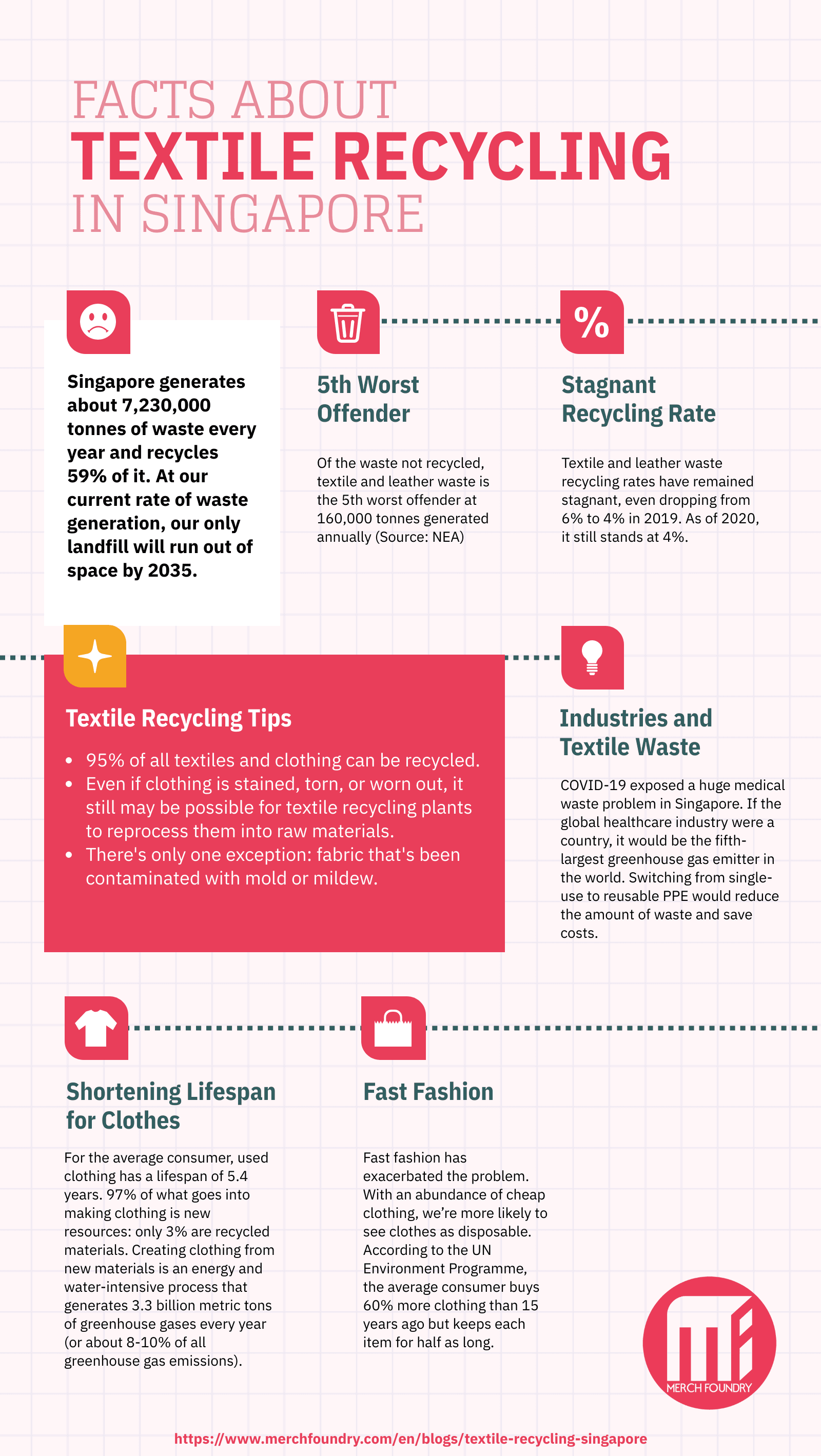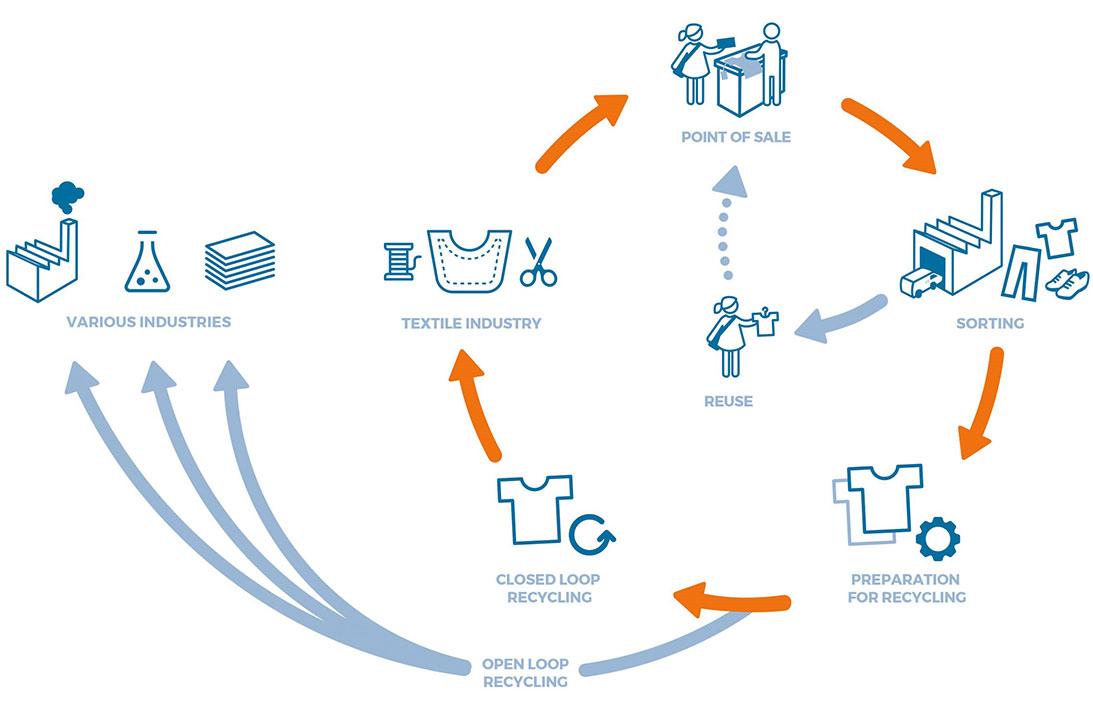Corporate Textile & Garment Recycling [A How-to Guide]
You’re probably no stranger to the Zero Waste Nation campaign that’s been promoted throughout hawker centres and community hubs in Singapore. Paper, cardboard, plastic, and food waste are all issues we’re trying to tackle in our bid for sustainability.
But what you may not realise is that Singapore’s textile recycling rate needs to pick up as well -- and there’s a lot you can do about it.
Today, we’ll go through:
- What textile recycling is
- How it works
- What textiles can be recycled
- And how you can help!
What is Textile Waste Recycling?
Textile recycling is when used clothing and other textiles are collected, processed, and re-distributed. These recycled textiles typically go to lower-income communities, are processed into raw materials, or are repurposed into fabrics such as industrial cleaning cloths.
Why is Textile Recycling Important for Singapore?
Most textiles end up in landfills, and creating clothing from new materials is an energy- and water-intensive process that generates 3.3 billion metric tons of greenhouse gases every year (or about 8-10% of all greenhouse gas emissions). Singapore’s only landfill is also set to run out of room by 2035 with our current rate of waste generation.
Fortunately, there is hope -- 95% of all textiles and clothing can be recycled. (The remaining 5% can’t be recycled because of mildew or other contamination.)
In 2020, Singapore’s textile/leather recycling rate was 4% -- the worst of all the categories. If we can turn this around, used textiles can become an affordable source of clothing for lower-income groups or raw material for new products.
The dismal statistic makes sense if you think about it. When was the last time you carted off a whole sack of old clothing to the textile recycling collections? For many of us, that favourite T-shirt first became sleepwear, then perhaps a cleaning rag, then simply thrown into the bin at the end of its usefulness.
Other seasonal fashion statements were worn a few times, then forgotten in the back of the closet when the trendsetters moved on.
Fast fashion has only exacerbated the problem. With an abundance of cheap clothing, we’re more likely to see clothes as disposable. According to the UN Environment Programme, the average consumer buys 60% more clothing than 15 years ago but keeps each item for half as long.
Interesting Facts about Textile Waste Recycling in Singapore
Singapore generates about 7,230,000 tonnes of waste every year and recycles 59% of it. Of the waste not recycled, textile and leather waste is the 5th worst offender at 160,000 tonnes generated annually.
Thanks in part to government initiatives like Zero Waste Nation, we’ve decreased the waste generated as a whole. But textile and leather waste recycling rates have remained stagnant, even dropping from 6% to 4% in 2019.
Natural fabrics like cotton easily break down with the right compost. Synthetic fabrics like polyester, spandex, and nylon eventually break down, but may take 20-200 years to do so.
For the average consumer, used clothing has a lifespan of 5.4 years. 97% of what goes into making clothing is new resources: only 3% are recycled materials.
COVID-19 exposed a huge medical waste problem in Singapore. If the global healthcare industry were a country, it would be the fifth-largest greenhouse gas emitter in the world. Switching from single-use to reusable PPE would reduce the amount of waste and save costs.

How Does Textile Recycling Work?
Textile recycling is split into three main processes: collecting, processing, and distributing.
In general, companies that provide textile recycling services fall into one of these three categories. But Singapore doesn’t have a textile recycling plant on the island, so most companies here are collectors and distributors.
Local textile recycling companies collect the old clothing and fabric, then:
- Donate them to nursing homes, non- profit organisations, and lower-income groups,
- Export them to overseas markets to be sold,
- Ship them to a textile recycling plant overseas to be processed into raw materials, or
- Send them out as industrial cleaning cloths.
Merchfoundry also collects recycled textiles from local organisations and businesses. Find out more about our sustainability marathon here.
What Textiles Can Be Recycled?
Almost any piece of clothing or fabric can be recycled as long as it’s dry, clean, and odourless. Even if it’s stained, torn, or worn out, textile recycling plants may still be able to reprocess them into raw materials.
There’s only one exception: mildew-contaminated clothing. You can spot mildew contamination by its smell: your clothes will carry a strong musty, earthy odour. There may also be white or black mold spots on the fabric.
Merchfoundry’s textile recycling collection prefers the following:
- Garments that are in good condition (i.e. not stained or worn out). These will be donated to non-profit organisations, nursing homes, dormitories, and underdeveloped countries. Clothes that are XL or larger have a higher chance of being recycled or repurposed.
- Clothes or fabrics that are absorbent. These typically have a high cotton content -- the higher the better. These will be recycled into industrial cleaning cloths.
Clothes and fabrics that are not absorbent will be shipped to recycling factories, where they’ll determine if the cloth can be reused for other purposes or recycled at the fibre level.
How Can You Help with Textile Recycling?
Whether you’re an individual or an organisation, here are 5 ways you can help:
1. Choose sustainable clothing.
Ditch fast fashion for its slow counterpart instead. Slow fashion, or sustainable fashion, focuses on eco-friendliness through the entire system of fashion. This means everything from sourcing, processing, and transportation minimises its carbon footprint as much as possible.
Buying from local brands is one way to accomplish this, but there are also several retailers dedicated to sustainable fashion.
2. Request a textile recycling bin for your organisation.
Merchfoundry can set up collection stations for good quality recyclables, which will then be donated to non-profits, nursing homes, dormitories, or nearby countries for reuse. Clothing that cannot be reused will be shipped to an overseas textile recycling facility to be reprocessed or upcycled as industrial cleaning cloths.
To request a textile collection bin, you’ll first need to roughly gauge the amount of textile waste your organisation produces. This will determine the collection frequency. Then, fill out the form at the bottom of this page.
3. Opt for reusable eco-friendly options whenever possible.
COVID-19 saw a surge in the use of single-use PPE. While we certainly understand the need for caution in an ongoing pandemic, we also can’t overstate the damaging impact these disposables have created.
On top of that, industries such as healthcare and hospitality tend to generate high amounts of textile waste. Healthcare, for example, is the fifth-largest greenhouse gas emitter in the world. Mitigating the impact of these industries will go a long way toward sustainability.
4. Compost them.
That’s right: your old clothing can join the ranks of kitchen waste in becoming a lovely, crumbly pile of compost for your growing garden. This only applies to natural fabrics, obviously -- cotton, hemp, bamboo, linen, wool and silk are all compostable.
5. Use them in crafts.
There’s no end to the number of things you could create with old fabric: lanyards, iPhone armbands, pouches, shopping bags, and even kids’ clothing. The only limit is your imagination. If you’re not that handy with a needle and thread, not to worry: there are a number of sewing courses you can take using your SkillsFuture credits.
Manufacturing plants, hospitals & labs use MF to automate orders and manage their uniforms.
Learn more
